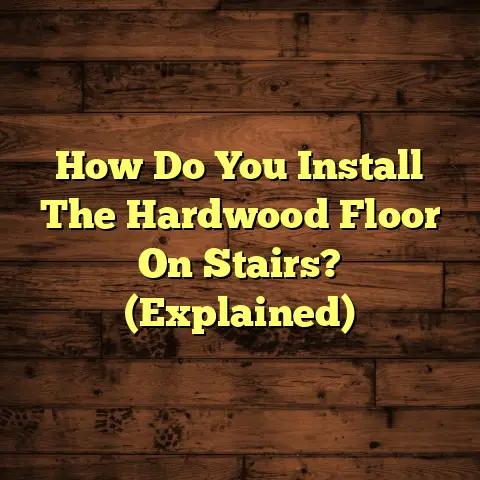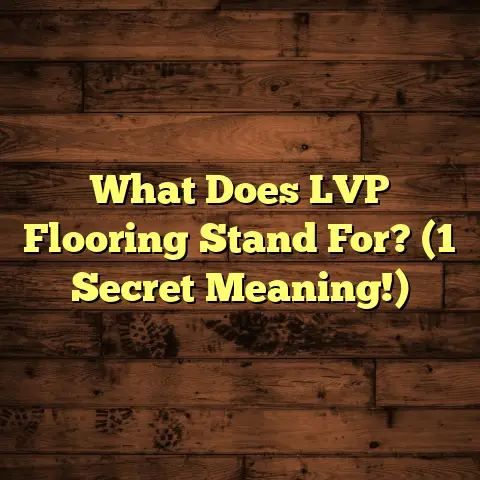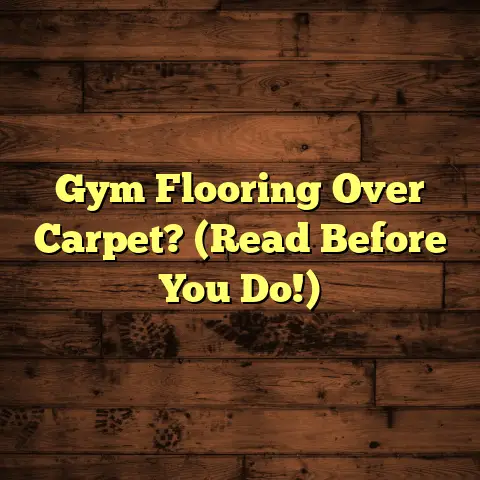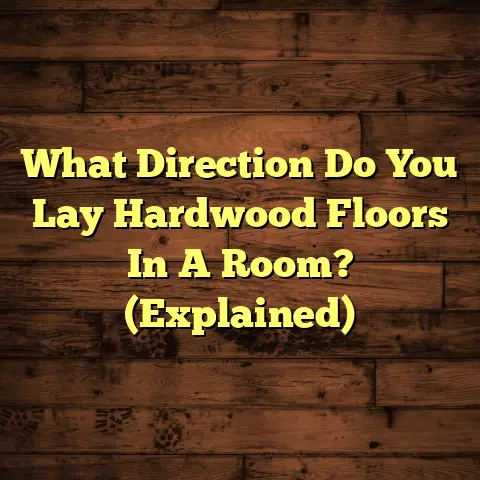Level A Floor With A Laser? (1 Pro Secret!)
And trust me, as a flooring contractor for over 15 years, I’ve seen it all. From creaky old houses to brand-new constructions with… character. (We’ll call it that.)
The good news? Perfectly level floors are achievable. And today, I’m going to walk you through how to do it using laser leveling – and I’m even going to share my top-secret pro tip that’ll make all the difference.
We’re talking about the difference between a “meh” job and a “wow, this looks professionally done” job. Ready to dive in? Let’s get started!
Section 1: Understanding the Basics of
Floor Leveling
So, what is floor leveling anyway? And why should you even care?
Simply put, floor leveling is the process of creating a perfectly horizontal surface on your subfloor. This is crucial for a bunch of reasons:
-
Aesthetics: Nobody wants furniture that wobbles or tiles that look wonky. A level floor creates a visually appealing and professional finish.
-
Functionality: Uneven floors can cause problems with door alignment, furniture stability, and even the lifespan of your flooring materials.
-
Safety: Tripping hazards are no joke! Leveling your floor eliminates those sneaky little bumps and dips that can send you sprawling.
Traditional Methods vs. Laser Leveling
Back in the day, we relied on long levels, straightedges, and a whole lot of eyeballing. (And let’s be honest, a bit of luck.) These methods have their limitations:
-
Accuracy: It’s tough to get a truly accurate reading over a large area with just a level.
-
Time-Consuming: Constantly moving the level and checking different spots can take forever.
-
Effort: It’s physically demanding, especially when dealing with large areas.
Enter laser leveling technology! These handy devices project a perfectly level laser beam across the room, giving you a precise reference point for leveling.
Think of it as having a super-accurate, never-tiring assistant. The advantages are clear:
-
Precision: Laser levels are incredibly accurate, allowing you to achieve a near-perfectly level surface.
-
Efficiency: They save you time and effort by providing a constant, reliable reference point.
-
Versatility: Laser levels can be used for a variety of flooring projects, from small bathrooms to large commercial spaces.
Types of Laser Levels
Not all laser levels are created equal. Here’s a quick rundown of the most common types you’ll encounter in flooring projects:
-
Rotary Laser Levels: These project a 360-degree laser beam, making them ideal for large, open areas. They’re often used for setting the overall level of a room or building.
-
Line Laser Levels: These project a single laser line, which is useful for aligning tiles, cabinets, or other features. They’re more compact and affordable than rotary lasers.
-
Laser Distance Measurers: While not strictly “leveling” tools, these can be incredibly helpful for measuring distances and calculating elevation differences. This can aid in assessing the floor’s condition before leveling.
As a pro, I mostly use rotary laser levels. They offer the best coverage and accuracy for larger flooring projects, especially when combined with a laser detector for enhanced visibility.
Section 2: Tools and Equipment for
Laser Leveling
Okay, let’s talk gear. Here’s what you’ll need to get the job done right:
-
Laser Level: Obviously! Choose the right type for your project size and budget.
-
Laser Detector (Optional but Recommended): This enhances the visibility of the laser beam, especially in bright conditions.
-
Tripod: A sturdy tripod is essential for keeping your laser level stable and at the correct height.
-
Leveling Compound: This is the magic potion that fills in the low spots and creates a smooth, level surface. Choose a self-leveling compound for best results.
-
Mixing Bucket and Drill Mixer: You’ll need these to properly mix the leveling compound.
-
Trowel and Screed: These are used to spread and smooth the leveling compound.
-
Spiked Roller (Optional): This helps to release any trapped air bubbles in the leveling compound.
-
Protective Gear: Safety glasses, gloves, and a dust mask are a must!
-
Measuring Tape and Pencil: For marking reference points and measuring distances.
Choosing the Right Laser Level
With so many options on the market, how do you choose the right laser level for your project? Here are a few things to consider:
-
Range: Make sure the laser level has a sufficient range for the size of your room.
-
Accuracy: Look for a laser level with an accuracy of at least ±1/8 inch per 100 feet.
-
Self-Leveling: This feature automatically levels the laser, saving you time and effort.
-
Battery Life: Consider the battery life of the laser level, especially if you’re working on a large project.
-
Price: Laser levels can range in price from a few hundred dollars to several thousand. Set a budget and stick to it.
I personally recommend investing in a quality laser level from a reputable brand. It’ll save you headaches in the long run. And don’t skimp on the tripod! A wobbly tripod can throw off your entire leveling process.
Section 3: Preparing for Laser
Floor Leveling
Alright, you’ve got your tools, now it’s time to prep the battlefield. Proper preparation is key to a successful laser leveling project.
Assessing the Floor
First, you need to get a good understanding of the current state of your floor. Here’s how:
-
Visual Inspection: Look for obvious signs of unevenness, such as dips, humps, and cracks.
-
Rolling Ball Test: Place a small ball (like a marble) on the floor in different areas. If it rolls consistently in one direction, you’ve got a slope.
-
Long Level Test: Use a long level (at least 6 feet) to check for unevenness across the floor.
-
Laser Measurement: Use your laser distance measurer to take height readings at various points across the floor. This will give you a precise understanding of the elevation differences.
Clearing the Area
Once you’ve assessed the floor, it’s time to clear the area. Remove all furniture, appliances, and other obstructions. Sweep or vacuum the floor thoroughly to remove any dust, debris, or loose particles.
Cleaning the Surface
A clean surface is essential for proper adhesion of the leveling compound. Use a degreaser to remove any oil, grease, or wax from the floor. Rinse thoroughly with clean water and allow the floor to dry completely.
Priming the Floor
Some leveling compounds require a primer to be applied to the floor before application. Check the manufacturer’s instructions and apply the primer accordingly. This will help the leveling compound bond properly to the subfloor.
Checklist Before You Begin
- [ ] Floor assessed for unevenness
- [ ] Area cleared of all obstructions
- [ ] Floor cleaned and degreased
- [ ] Primer applied (if required)
- [ ] All tools and equipment ready
Section 4: The Laser Leveling Process
Step-by-Step
Okay, the moment of truth! Here’s how to level your floor using a laser level, step-by-step:
-
Set Up the Laser Level: Place the laser level on a stable tripod in the center of the room. Adjust the height of the tripod so that the laser beam is at a comfortable working height.
-
Calibrate the Laser Level: Turn on the laser level and allow it to self-level. If your laser level doesn’t have a self-leveling feature, you’ll need to manually adjust it until the bubble level is centered.
-
Mark Reference Points: Using a measuring tape and pencil, mark reference points on the walls around the perimeter of the room. The laser beam will serve as your guide for these reference points.
-
Determine the Highest Point: Find the highest point on the floor using the laser level. This will be your zero point.
-
Calculate the Leveling Compound Thickness: Measure the distance from the laser beam to the floor at various points. The difference between the laser beam and the zero point will determine the thickness of the leveling compound needed at each location.
-
Mix the Leveling Compound: Follow the manufacturer’s instructions to mix the leveling compound. Use a drill mixer to ensure a smooth, lump-free consistency.
-
Pour and Spread the Leveling Compound: Pour the leveling compound onto the floor, starting at the deepest areas. Use a trowel and screed to spread the compound evenly, ensuring that it reaches all the low spots.
-
Use a Spiked Roller (Optional): If you’re using a self-leveling compound, use a spiked roller to release any trapped air bubbles.
-
Allow to Cure: Allow the leveling compound to cure according to the manufacturer’s instructions. This may take anywhere from 24 to 72 hours.
-
Check for Levelness: Once the leveling compound has cured, check the floor for levelness using the laser level. If necessary, apply a second coat of leveling compound to any remaining low spots.
Section 5: The Pro Secret Revealed
Alright, folks, here it is – the pro secret that can take your laser floor leveling game to the next level:
Use a Laser Detector with a Grade Function!
What’s a grade function? Well, most people think of laser levels as just tools for creating a perfectly horizontal plane. But did you know that some laser detectors allow you to set a slope?
That’s right! Instead of just beeping when the laser hits the detector at the same level, you can set it to beep when it’s at a slightly different level.
Why This Matters
Think about it. Not all floors should be perfectly level. In bathrooms, for example, you want a slight slope towards the drain to prevent water from pooling.
And even in other rooms, a perfectly level floor can sometimes look… unnatural. A slight, almost imperceptible slope can actually make the room feel more organic and inviting.
How to Use It
-
Set Your Desired Slope: Consult with your building codes or your own design preferences to determine the appropriate slope for your floor. A typical slope for a bathroom floor is 1/4 inch per foot.
-
Set the Grade on Your Laser Detector: Follow the manufacturer’s instructions to set the grade on your laser detector. This will tell the detector to beep when it’s at the desired slope relative to the laser beam.
-
Level to the Grade: When applying the leveling compound, use the laser detector to guide you. Instead of aiming for a perfectly level surface, aim for the desired slope.
Real-World Example
I once worked on a high-end bathroom remodel where the client specifically requested a very subtle slope towards the shower drain. Using a laser detector with a grade function allowed me to achieve this with perfect precision. The result was a bathroom that was both functional and aesthetically pleasing.
Section 6: Common Mistakes and
Troubleshooting
Even with the best tools and techniques, mistakes can happen. Here are some common pitfalls to avoid when leveling floors with a laser:
-
Not Properly Preparing the Floor: As I mentioned earlier, proper preparation is key. Don’t skip steps like cleaning, degreasing, and priming.
-
Using the Wrong Leveling Compound: Different leveling compounds are designed for different applications. Choose the right one for your subfloor material and the amount of leveling required.
-
Mixing the Leveling Compound Incorrectly: Follow the manufacturer’s instructions carefully when mixing the leveling compound. Too much or too little water can affect its consistency and performance.
-
Applying the Leveling Compound Too Thickly: Applying the leveling compound in thick layers can cause it to crack or shrink as it dries. Apply multiple thin layers instead.
-
Not Allowing Enough Curing Time: Rushing the curing process can lead to problems down the road. Be patient and allow the leveling compound to cure completely before installing your flooring.
Troubleshooting Tips
-
Air Bubbles: If you see air bubbles in the leveling compound, use a spiked roller to release them.
-
Cracks: If the leveling compound cracks as it dries, it may be due to applying it too thickly or not properly preparing the floor. Apply a second coat of leveling compound to fill in the cracks.
-
Unevenness: If the floor is still uneven after the leveling compound has cured, apply a second coat of leveling compound to any remaining low spots.
Section 7: Post-Leveling Steps and
Maintenance
Congratulations! You’ve successfully leveled your floor using a laser level. But the job isn’t quite done yet. Here are a few finishing touches and maintenance tips to keep your floor level for years to come:
-
Curing Time: As mentioned, give the leveling compound the full curing time recommended by the manufacturer. This is crucial for its strength and durability.
-
Sealing (Optional): Depending on the type of leveling compound you used, you may want to seal it to protect it from moisture and wear.
-
Installing Your Flooring: Once the leveling compound has fully cured, you can install your chosen flooring material.
-
Regular Cleaning: Keep your floor clean and free of debris to prevent scratches and wear.
-
Monitoring: Periodically check your floor for any signs of unevenness or damage. Address any issues promptly to prevent them from worsening.
When to Call a Pro
While laser floor leveling is a DIY-able project, there are times when it’s best to call in a professional. These include:
-
Large Areas: Leveling a very large area can be challenging and time-consuming.
-
Severe Unevenness: If your floor is severely uneven, it may require specialized equipment and techniques to level it properly.
-
Structural Issues: If the unevenness is caused by structural issues, such as a settling foundation, it’s important to address the underlying problem before leveling the floor.
-
Lack of Experience: If you’re not comfortable with the process, it’s always best to hire a professional to ensure a successful outcome.
Conclusion: Recap and Encouragement
So, there you have it – a comprehensive guide to leveling floors with a laser, complete with my top-secret pro tip!
Remember, laser leveling is a powerful tool that can help you achieve professional-quality results. By following the steps outlined in this article and incorporating the grade function on your laser detector, you can create a perfectly level (or slightly sloped) floor that will enhance the beauty, functionality, and safety of your home.
Don’t be afraid to experiment and learn from your mistakes. With a little practice, you’ll be leveling floors like a pro in no time! Now go out there and create some level surfaces! You got this!





